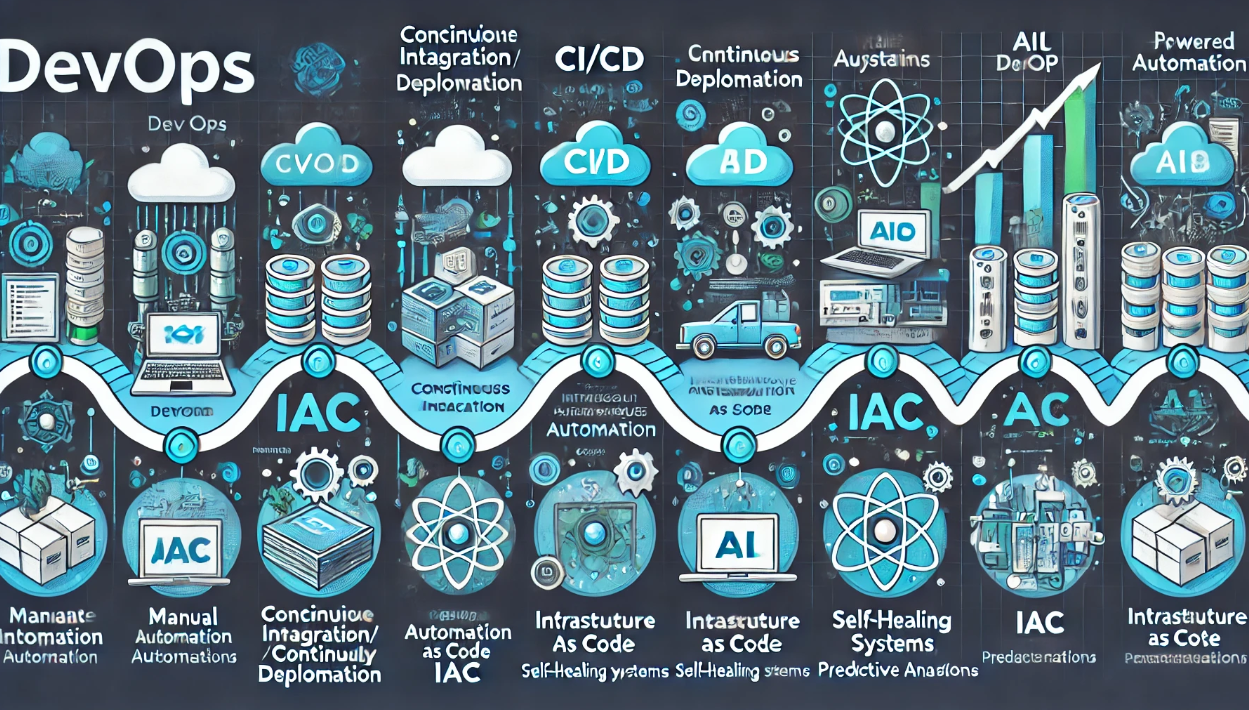The Evolution of DevOps in 2025: From CI/CD to AI-Driven Development
DevOps has evolved from basic Continuous Integration/Continuous Deployment (CI/CD) pipelines to AI-powered automation, self-healing infrastructure, and intelligent monitoring. As organizations embrace AI-driven DevOps, the focus is shifting from manual intervention to self-learning, self-optimizing software development.
✅ In this guide, we’ll explore:
- The Evolution of DevOps: From CI/CD to AI-Driven Development
- AI’s Role in Automating DevOps
- ⚡ The Future of DevOps: Self-Healing Systems & NoOps
- Challenges & Best Practices for AI-Powered DevOps
Let’s dive into how DevOps is transforming in 2025!
The Evolution of DevOps: From CI/CD to AI-Driven Development
1. Traditional DevOps: CI/CD Pipelines
✔️ CI/CD automates code integration, testing, and deployment.
✔️ Infrastructure as Code (IaC) tools like Terraform & Ansible enable scalable automation.
✔️ Monitoring tools (Prometheus, Grafana, ELK Stack) track performance issues.
Example: DevOps teams use Jenkins + Kubernetes to deploy microservices automatically.
2. DevOps in 2025: AI & Machine Learning Integration
✔️ AI-driven DevOps (AIOps) uses machine learning to predict failures before they happen.
✔️ Self-optimizing CI/CD pipelines analyze past deployments to reduce errors.
✔️ Intelligent incident response uses AI to automatically resolve issues without human intervention.
Example: AI-powered GitHub Copilot assists developers by suggesting optimized code fixes in real time.
AI’s Role in Automating DevOps
✅ 1. AI-Driven CI/CD Pipelines
✔️ Automated testing ensures faster deployments with fewer bugs.
✔️ AI-powered regression testing predicts code failure points before deployment.
✔️ Self-learning build pipelines optimize compilation and deployment speeds.
Example: AI-driven JenkinsX adjusts test execution based on historical build performance.
✅ 2. AI-Powered Code Review & Optimization
✔️ AI analyzes code commits to detect potential security vulnerabilities.
✔️ Machine learning models optimize code performance & memory usage.
✔️ AI suggests best coding practices for maintainability.
Example: DeepCode scans repositories and suggests performance improvements automatically.
✅ 3. Self-Healing Infrastructure & NoOps
✔️ AI-powered monitoring tools automatically detect & fix infrastructure issues.
✔️ Self-healing Kubernetes clusters reallocate resources based on workload demand.
✔️ NoOps (No Operations) means fully automated IT management with minimal human intervention.
Example: AWS Auto Healing EC2 Instances restart automatically when an issue is detected.
✅ 4. AI-Driven Incident Management
✔️ AI-driven chatbots resolve common DevOps issues autonomously.
✔️ Predictive monitoring prevents system failures before they occur.
✔️ AI-powered log analysis identifies root causes faster than humans.
Example: Datadog AI Log Explorer detects anomalous behavior in real-time.
⚡ The Future of DevOps: Self-Healing Systems & NoOps
1. What is NoOps?
✔️ NoOps eliminates manual infrastructure management using AI & automation.
✔️ Cloud providers like AWS, Azure, and Google Cloud handle automated scaling & monitoring.
✔️ AI-driven DevSecOps integrates security into development workflows.
Example: Google Kubernetes Engine (GKE) auto-scales workloads without human intervention.
2. The Rise of GitOps & MLOps
✔️ GitOps automates infrastructure deployment using Git repositories as the single source of truth.
✔️ MLOps (Machine Learning Operations) integrates AI model deployment into DevOps workflows.
Example: ArgoCD + Kubernetes enables automated infrastructure rollouts using GitOps principles.
3. AI-Generated Infrastructure as Code (IaC)
✔️ AI writes Terraform & Ansible scripts, eliminating manual scripting errors.
✔️ Infrastructure auto-scales based on real-time demand predictions.
Example: Pulumi AI generates optimized Terraform configurations automatically.
Challenges & Best Practices for AI-Powered DevOps
✅ 1. Managing AI Bias in DevOps Automation
✔️ AI models must be continuously monitored to avoid biased decision-making.
✔️ Human oversight is still required for critical security & compliance checks.
Example: AI-driven vulnerability scanners must be fine-tuned to reduce false positives.
✅ 2. Balancing Automation & Human Expertise
✔️ 100% automation isn’t feasible—DevOps engineers must override AI recommendations when necessary.
✔️ Organizations should invest in AI training for DevOps teams.
Example: AI-powered CI/CD pipelines require manual intervention for major security updates.
✅ 3. Security Concerns in AI-Driven DevOps
✔️ AI-generated scripts must be audited for potential security vulnerabilities.
✔️ Organizations should use AI-powered security tools (DevSecOps) to detect threats in real-time.
Example: Snyk AI scans container images & Kubernetes configurations for security flaws.
Final Thoughts: How DevOps is Evolving in 2025
✅ Key Takeaways:
✔️ AI-driven automation is transforming DevOps, making CI/CD pipelines smarter & more efficient.
✔️ NoOps & Self-Healing Systems will reduce manual infrastructure management.
✔️ GitOps & MLOps will streamline software deployment & AI model training.
✔️ AI-powered security tools will prevent cyber threats before they happen.
**By embracing AI-driven DevOps, businesses can achieve faster deployments, fewer outages, and improved security!

